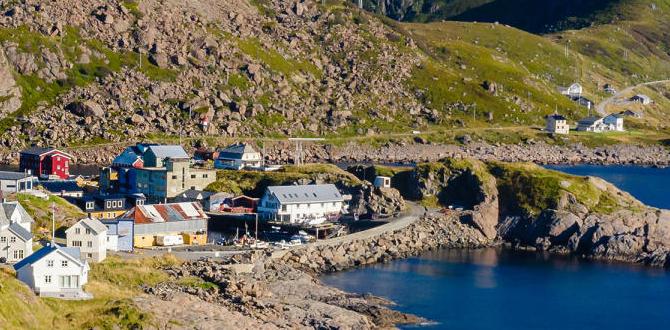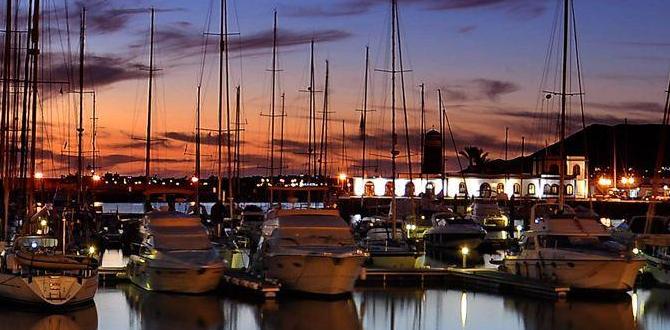Baja California’s best time to visit for fewer crowds is during the shoulder seasons: spring (April to May) and fall (September to November). These periods offer pleasant weather and significantly reduced visitor numbers compared to peak times.
Planning a trip to beautiful Baja California can sometimes feel overwhelming, especially when you dream of sunny beaches and serene desert landscapes without the hustle and bustle. Many travelers find themselves battling crowds, which can make even the most relaxing vacation feel stressful. But what if you could enjoy the magic of Baja without the throngs of people? It’s absolutely possible! We’re here to show you exactly when to go to experience the peninsula’s charm at its most peaceful. Get ready for an effortless journey to paradise, tailored for comfort and ease.
Why Avoiding Crowds Matters for Your Baja Trip
When you envision your Baja California getaway, chances are images of quiet beaches, unhurried exploration, and authentic local encounters come to mind. Overcrowding can quickly turn these dreams into a less-than-ideal reality. Long lines at attractions, packed restaurants, and crowded popular spots can drain your energy and diminish the sense of calm you’re seeking. For families, especially those managing travel with younger children or needing extra comfort considerations like adult or child diapers for ease and discretion, avoiding crowds is paramount for a smooth and enjoyable experience. Reduced crowds mean more space, shorter waits, and a more authentic connection with the destination, making your travel truly effortless and memorable.
Understanding Baja California’s Seasons
Baja California, a long, narrow peninsula in Mexico, offers a diverse range of climates and experiences throughout the year. Understanding these seasonal shifts is key to finding your perfect, crowd-free window.
The peninsula stretches from just below San Diego, California, all the way down to the tip, encompassing distinct regions like the Pacific coast, the Sea of Cortez, and the desert interior. Each area has its own microclimate and peak tourist seasons, influenced by weather patterns, local events, and international travel trends.
Peak Tourist Season: The Winter Rush
From December through March, Baja California experiences its peak tourist season. This is largely driven by North American travelers escaping colder winter climates. The weather is exceptionally pleasant – sunny, warm, and with minimal humidity. It’s also prime time for whale watching, particularly in areas like Magdalena Bay and San Ignacio Lagoon, where magnificent gray whales migrate to breed and calve. While the weather is undeniably perfect, this is also when you’ll encounter the largest crowds and the highest prices for accommodations and flights.
What to Expect During Peak Season:
- Weather: Ideal – sunny, warm days, cool evenings.
- Activities: Excellent for whale watching, water sports, exploring towns.
- Crowds: High, especially in popular destinations like Cabo San Lucas, La Paz, and Ensenada.
- Prices: Highest of the year for flights and lodging.
- Vibe: Lively and bustling.
The Summer Heat and Smaller Vacationers
June, July, and August bring the heat and humidity to Baja California, especially in the southern regions. While this is a popular time for families on summer break and domestic Mexican tourists, it’s generally less appealing for international visitors seeking milder weather. Daytime temperatures can soar, making strenuous outdoor activities less comfortable. However, the waters of the Sea of Cortez are warm and vibrant, ideal for snorkeling and diving for those who don’t mind the heat. You’ll find fewer international tourists, but local and family vacationers will still be present.
What to Expect During Summer:
- Weather: Hot and humid, especially in the south. Occasional summer thunderstorms.
- Activities: Great for swimming, snorkeling, diving in warm waters.
- Crowds: Moderate, with more domestic and family travelers.
- Prices: Can be slightly lower than winter, but still active due to summer holidays.
- Vibe: Energetic but manageable.
Shoulder Seasons: Your Sweet Spot for Fewer Crowds
This is where the magic happens for travelers seeking a more tranquil Baja experience. The shoulder seasons offer a fantastic balance of excellent weather and significantly fewer people.
Spring: April to May
As the winter crowds dissipate, spring emerges as a wonderful time to visit. The weather remains consistently pleasant, with warm days and comfortable evenings. The intense heat of summer hasn’t yet arrived, making it perfect for exploring historical missions, hiking in the desert, or enjoying the beaches without feeling overwhelmed. Whale watching season is winding down, but you might catch some late stragglers. This period is ideal for a relaxed pace, allowing for spontaneous detours and more intimate experiences.
Fall: September to November
The scorching summer temperatures begin to recede, giving way to beautiful, sunny days and cooler nights. September can still be warm, especially in the early part of the month, but by October and November, you’ll find near-perfect weather across the peninsula. The hurricane season officially ends on November 30th, and while direct hits are rare, the early fall can sometimes see storm activity. Once past any early September heat or potential weather disruptions, the fall offers a serene atmosphere, with fewer tourists than winter but with delightful conditions for all kinds of activities.
Baja California: Best Time to Visit Without Crowds – A Comparison
To help you visualize when your ideal Baja trip might fall, let’s compare the seasons based on crowd levels and weather.
| Season | Months | Crowd Level | Weather | Best For |
|---|---|---|---|---|
| Winter (Peak) | December – March | Highest | Warm, sunny, dry | Whale watching, mild temperatures |
| Spring (Shoulder) | April – May | Low to Moderate | Warm, pleasant, less humid | Exploring, hiking, enjoying beaches calmly |
| Summer | June – August | Moderate (domestic/family) | Hot, humid (especially south) | Water sports, warm ocean swims |
| Fall (Shoulder) | September – November | Low to Moderate | Warm to pleasant, less humid (after early Sept) | Relaxed exploration, enjoying pleasant temps |
Effortless Planning: Targeting the Shoulder Seasons
Now that you know when to go, let’s talk about making the planning effortless. Targeting the shoulder seasons is your secret weapon.
Step 1: Choose Your Region Wisely
Baja California is vast. While generally less crowded during shoulder seasons, some areas might still see more activity. Research the specific part of Baja you want to visit:
- La Paz & Espíritu Santo Island: Spring (April-May) and Fall (October-November) are fantastic. You’ll avoid the winter whale watching rush and the intense summer heat. Snorkeling and diving are excellent during these times.
- Todos Santos: This charming artsy town is lovely in spring and fall. It offers a more laid-back vibe than Cabo year-round but is particularly serene during the shoulder seasons.
- Cabo San Lucas & San Jose del Cabo: While always popular due to resorts and nightlife, the crowds are noticeably thinner in April-May and September-October (avoiding the peak holiday weeks).
- Loreto: Known for its marine park and tranquil atmosphere, Loreto is ideal in spring and fall when the weather is perfect for kayaking, island hopping, and exploring.
- Ensenada & Valle de Guadalupe: The shoulder seasons here are a dream for wine lovers and foodies. Spring offers blooming vineyards, and fall is harvest season, but without the full winter tourist influx.
Step 2: Book Your Flights and Accommodation in Advance (But Not Too Far)
Even during shoulder seasons, popular destinations book up. Aim to book flights and lodging about 3-6 months in advance. This gives you access to better prices and a wider selection of rooms or rental properties. Websites like Kayak or FlightAware can help you track flight prices leading up to your booking window.
Consider unique stays: Bed and breakfasts, small boutique hotels, or Airbnb rentals often offer a more intimate experience and can be less impacted by large tour group bookings.
Step 3: Pack Smart for Comfort
Packing strategically is key to stress-free travel, especially if you need to bring along essentials like adult or child diapers. The shoulder seasons offer wonderful weather, but it’s wise to be prepared for variations.
Spring Packing Essentials:
- Lightweight clothing (shorts, t-shirts, sundresses)
- A light jacket or sweater for cooler evenings
- Swimsuit
- Sun hat and sunglasses
- Comfortable walking shoes
- Sunscreen (reef-safe if possible)
- For those who need them, discreet and comfortable adult or child diapers for day trips or travel days. Look for options designed for discretion and absorbency, like Depend for men and women or specialized brands for children, ensuring comfort and confidence throughout your adventures.
Fall Packing Essentials:
- Similar to spring, but perhaps a slightly warmer layer for evenings, especially in later November.
- Light, breathable fabrics remain important.
- Don’t forget insect repellent, as some evenings can still have mosquitos.
Having your comfort needs met, like reliable and comfortable diaper solutions, frees you up to focus on the joy of your trip. For accessible and discreet options, exploring retailers like Target’s adult incontinence section or online pharmacies can be very helpful in planning ahead.
Step 4: Plan Key Activities, But Leave Room for Spontaneity
While you’re aiming for fewer crowds, popular tours or experiences might still benefit from advance booking. This includes things like whale watching tours (if you catch the very tail end of the season), popular guided hikes, or diving excursions.
However, the beauty of visiting during the shoulder season is the reduced pressure. You’ll find it easier to book last-minute dinner reservations, join a smaller group for a sunset cruise, or simply decide to spend an extra hour on a quiet beach without feeling rushed. This flexibility is what makes the trip truly effortless.
Activities to Enjoy in Baja California (Crowd-Free)
During the shoulder seasons, you can fully immerse yourself in Baja’s incredible offerings with ease.
Whale Watching (Late Season)
If you visit in late March or early April, you might still catch the tail end of the incredible gray whale migration. While the peak is in January and February, these late sightings can be just as magical, and with fewer boats out, the experience feels more intimate. Organizations like the World Wildlife Fund provide excellent information on whale conservation and migration patterns.
Exploring Desert Landscapes
Baja’s desert is a unique and stunning environment. During April-May and September-November, the temperatures are much more forgiving for hiking, exploring canyons, or visiting the historic Jesuit missions scattered throughout the peninsula. The flora is often vibrant, especially after any spring rains. Websites like National Park Service often have general information on desert survival and appreciation, which can be applied to understanding Baja’s arid beauty.
Water Activities in the Sea of Cortez
The Sea of Cortez, known as the “world’s aquarium” by Jacques Cousteau, is teeming with marine life. In April-May and again from September through November, the water is generally clear and warm enough for snorkeling and diving. Kayaking amongst the islands, like those around Loreto or Espíritu Santo, is particularly serene during these times. The Marine Biodiversity and Conservation section of Mexico’s Ministry of Environment and Natural Resources offers insights into the importance of these protected waters.
You can explore pristine coves, swim with sea lions, or simply relax on secluded beaches that might be packed during peak winter months.
Gastronomic Adventures
Baja’s culinary scene is a delight. During the shoulder seasons, you can enjoy fresh seafood tacos, regional specialties, and excellent wines from the Valle de Guadalupe without fighting for a table. The experience feels more authentic when you can chat with chefs and locals without the noise of overwhelming crowds.
Road Tripping and Scenic Drives
Baja is a road-tripper’s paradise. With less traffic, driving between towns like Todos Santos, La Paz, and Loreto becomes a much more relaxed and enjoyable experience. You can stop at roadside stands, explore smaller villages, and soak in the stunning coastal and desert vistas at your own pace. For road travel tips, resources like the Federal Highway Administration offer general safety and planning advice applicable to any road trip.
Considerations for Travelers with Specific Needs
For anyone who requires specialized travel items, such as adult diapers or child diapers, visiting during the shoulder season can add an extra layer of comfort and reduce potential stress. Knowing you have ample space and fewer people to navigate around in public areas, airports, or on transport can be hugely reassuring.
Pre-trip preparation is key. Purchasing your required supplies from trusted sources like CVS or ensuring you have child diapers from stores like Target before you depart ensures you are well-equipped. This preparation allows you to focus on enjoying the natural beauty and peaceful atmosphere of Baja California, rather than worrying about logistics. Discreet and comfortable options are readily available, making travel manageable and dignified for all.
Frequently Asked Questions About Visiting Baja California Without Crowds
Q1: Is it always crowded in Baja California during winter?
A: Yes, winter (December to March) is Baja California’s peak season, meaning popular areas like Cabo San Lucas and La Paz will be the most crowded. This is due to people escaping colder weather. For fewer crowds, aim for the shoulder seasons.
Q2: What are the “shoulder seasons” for Baja California?
A: The shoulder seasons are the periods just before and after the peak season, offering a great balance of good weather and fewer tourists. In Baja California, these are generally April to May (spring) and September to November (fall).
Q3: Can I still see whales if I visit in the spring?
A: You can, but it’s towards the end of the season. The peak whale watching season for gray whales is typically January through March. Visiting in early April might still offer chances to see migrating whales, but the numbers will be much lower than in mid-winter.
Q4: Is it too hot to visit Baja California in the fall?
A: Early September can still be quite hot and humid, especially in the southern parts of the peninsula, and it’s also the end of hurricane season. However, by October and November, the weather significantly cools down, becoming very pleasant and comfortable for most travelers without the summer heat.
Q5: What are the benefits of traveling to Baja during the shoulder seasons?
A: The main benefits are significantly fewer crowds, often lower prices for flights and accommodations compared to peak season, and usually excellent weather. This allows for a more relaxed and authentic travel experience.
Q6: Are there still good deals on flights and hotels during the spring and fall?
A: While not as low as the summer off-season, you can often find better deals on flights and accommodations during the spring and fall shoulder seasons compared to the peak winter months. Booking a few months in advance is still recommended for the best prices and availability.
Q7: I have mobility issues and rely on adult diapers. Will visiting during the shoulder season make my trip easier?
A: Absolutely! Traveling during the shoulder season means less waiting in lines, less crowded transportation, and more space in public restrooms and attractions. This can greatly reduce stress and enhance comfort for travelers who need to manage personal care needs discreetly and conveniently.
Conclusion: Your Effortless Baja Escape Awaits
Baja California is a treasure trove of natural beauty, vibrant culture, and stunning coastlines. By strategically timing your visit for the shoulder seasons – April to May






